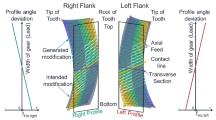Abstract
In many cases, gear honing represents a cost-efficient process for gear manufacturers. Another advantage of gear honing is the generation of a surface structure on the tooth flank which improves the noise behavior of the gear. Previous research activities have resulted in reliable gear honing processes, particularly for automotive gears with a tip diameter of up to 150 mm. Problems occur, however, when honing larger gears with a tip diameter of more than 150 mm, thereby rendering a robust manufacturing process is difficult. In the course of this paper, an analysis will be carried out of the geometrical and kinematic conditions that will lead to a better understanding of the process. The aim of this report is to provide an overview of the current basic conditions of the gear honing process. Theoretical studies are conducted to identify differences in gear honing processes with various tip diameters. This analysis forms the basis for optimizing process design, with the aim of generating a cost-efficient gear honing operation for gears with a tip diameter of more than 150 mm.






Similar content being viewed by others
References
Norm DIN 3960 (1987) Begriffe und Bestimmungsgrößen für Stirnradpaare (Zylinderräder) und (Zylinderpaare) mit Evolventenverzahnung
Köllner T (2000) Verzahnungshonen—Verfahrens-charakteristik und Prozessanalyse. Doctoral thesis, RWTH Aachen University
Bausch Th (2006) Verzahnungshonen, Innovative Zahnradfertigung—Verfahren, Maschinen und Werkzeuge zur kostengünstigen Herstellung von Stirn mit hoher Qualität, Expert Verlag, pp 590–637
Daniels K (1998) Verzahnungs-Honwerkzeuge: Spezifi-kation und geometrische Auslegung—Honprozeß und Standmenge, conference transcript “Praxis der Zahnradfertigung”, Esslingen, 18–20 March
Rütti R (2000) Beitrag zur Prozeßmodellierung am Beispiel des Zahnradhonens. Doctoral thesis, ETH Zürich
Yakaria H (2004) Geometrische und nicht linear elastische Zahnkontaktanalyse beim Verzahnungshonen. Doctoral thesis, RWTH Aachen University
Rütti R (2007) Verzahnungshonen: Moderne Hartfeinbearbeitung auf dem Vormarsch, workshop transcript “GETPRO—Kongress zur Getriebeproduktion”, Würzburg, 14–15 March
Schweickert S (2001) Beitrag zur Entwicklung des Leistunghonens von Verzahnungen. Doctoral thesis, ETH Zürich
Linke H (1996) Stirnradverzahnungen—Berechnung, Werkstoffe, Fertigung, Carl Hanser Verlag Wien
Ehren H-P (2001) Tragfähigkeitsreserven geradverzahnter Innenverzahungen durch die Zunahme der Überdeckung unter Last. Doctoral thesis, RWTH Aachen University
Author information
Authors and Affiliations
Corresponding author
Rights and permissions
About this article
Cite this article
Klocke, F., Gorgels, C. & Vasiliou, V. Analysis of the influence of gear dimensions on cutting speed and contact conditions during the gear honing process. Prod. Eng. Res. Devel. 3, 255–259 (2009). https://doi.org/10.1007/s11740-009-0165-1
Received:
Accepted:
Published:
Issue Date:
DOI: https://doi.org/10.1007/s11740-009-0165-1




